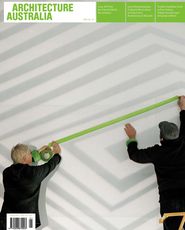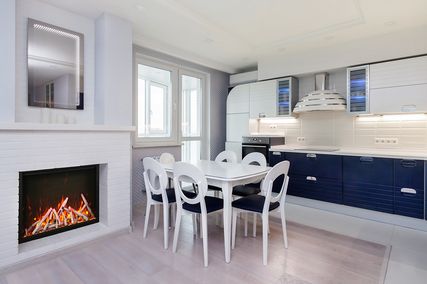Paul Walker, Peter Bennetts and Hamish Lyon
Hyperbole
Paul Walker
Hyperbole, hyperbole. How could anything live up to such an inflated idea as the World Architecture Festival? But whatever cynicism WAF might attract, the impulse at its heart – getting the international community of architects together to do show-and-tells – is really a very attractive one. The format of parallel juries hearing various categories of projects across a day, and responding with immediate questions and comments, is one that is familiar in Australia the presentations to jury for the Institute’s Victorian awards. That event is much enjoyed by those who participate and attend, and is often palpably exciting for the conversations that unfold, the crush of people to hear the big names, or the rising ones, and for its immediacy. WAF number two did not feel quite so vibrant as that. But it’s on its way. It too mixes well known names with the not so known, quirky projects with the polished. And attentive jurors with the opinionated.
My own experience on a jury (Future Projects – Culture) was fascinating. My colleagues were an earnest Danish architect (who, on learning of my New Zealand nationality, admitted that he had been inspired to an architectural career by seeing the wacky work of Wellington architect Roger Walker), and a well known English star who frequently veiled his steely grasp of the dilemmas in the projects we saw with cryptic comments on the presenter’s demeanour. “Did you consider wearing a suit today?” he pointedly asked the architect of a dreary Swedish city’s staid performing arts centre. But here perhaps is a key problem of WAF 09: the quality of the shortlisting was uneven. Whoever picked the finalists for Future Projects – Culture clearly wasn’t sure eventhow to construe “culture”. The municipal view? (Culture as something that happens in classy theatres – build them and it will come.) Or the anthropological? The jury gravitated to the latter, perhaps unfairly for work oriented to the former. In some categories this unfocused shortlisting produced a level of variability that left juries falling to the lowest common denominator (the absurd questions directed at Howard Raggatt about the construction of the Melbourne Recital Centre were the lowest of the low).
The main award of the event goes to a project chosen from the winners of the various categories of built projects. It was gratifying in a jingoistic way to see so much Australian-connected work there in the final: the Klein Bottle house by McBride Charles Ryan; the Berry Sports Hall by Allen Jack + Cottier; WOHA’s Bras Basah MRT Station in Singapore a Bangkok housing tower also by WOHA; and TKTS in Times Square NY by Choi Ropiha, Perkins Eastman, William Fellows/PKSB and Dewhurst MacFarlane and Partners. But the “super jury” that chose the winner was disappointing. Its chair, Rafael Vinoly, dominated the discussion but was inimical to anything too like an idea, while the “coolest” juror, Farshid Moussavi of Foreign Office Architects, hardly raised a peep in protest. Was the GFC was casting its shadow? If so, perhaps as it recedes WAF 3’s super jury might find a livelier mood.
Dr Paul Walker is associate professor of architecture at the University of Melbourne. He participated in the WAF as a representative of Architecture New Zealand, the New Zealand media partner of the WAF.
The Broad Brush

Judges, winners and sponsors dining at Mies van der Rohe’s Barcelona Pavilion on the second night of the event. Photograph Peter Bennetts.
Peter Bennetts
World Architecture Festival (WAF) II occupied three days in Barcelona in the first week of November. In the vast Centre Convencions Internacional Barcelona (CCIB) you could be excused for wondering where in the world you were and just what you were doing there. The WAF could be any anonymous conference in any anonymous conference facility save for the spruiking of Grohe tap fittings and the thinly spread architectural publishers. Herzog & de Meuron’s Forum building sits next to the CCIB seemingly unused, unloved and in need of a good clean, reflection pools fouled with rubbish – a great purple pin-up for the dangers of architecture?
Sadly the WAF this year was a lot more conference than festival. Last year Barcelona was awash with WAF banners and every cab driver knew the event. Not this year. Marking these gloomy economic times, the festival was scaled back on last year’s and flat Cava was grudgingly served at the opening so there’d be no misapprehension as to what the rest of the festival was going to be like. A visitor would be right to think that 695 euros is a lot to pay to attend.
The WAF is a juried architectural competition with a parallel seminar program and a series of keynote addresses. In essence it’s an opportunity for architects to come together from around the world to meet and learn from each other. It presents an unprecedented opportunity to view the greatest selection of the year’s architecture in a glance. There’s a gallery of all the entry A2 boards (with the short-listed entries all indicated correctly by the conference’s second day). Overall there’s a UK bias in the proportion of entries from that country, but that’s understandable considering the ownership of the event exhibitionby British publisher emap, who counts The Architecture Review among its mastheads.
The competition is divided into loose categories – “sport”, “house”, “housing”, “new & old”, “transport”, “landscape”, “learning”, “office” and so on, including a number of future project categories. These broad categories pose problems with short-listing: the immense Melbourne Convention Centre was short-listed in the “display” category along with two aviaries and a petting zoo. The jury questioned this short list and seemed dismayed at having to make an evaluative judgment on such diverse projects. The picturesque Cages for Macaws in the Palm Grove of Barcelona Zoo, Spain by Batlle & Roig Architects ultimately won “display”. Happy macaws.
Given the broad brush with which WAF paints I’d rather see projects awarded for making the world a better place.
Winning the “new & old” category and making New York a better place was the TKTS Booth and the Redevelopment of Father Duffy Square, New York, by Choi Ropiha, Australia (concept architect), Perkins Eastman, USA (architect), William Fellows/ PKSB (plaza architect), Dewhurst Macfarlane and Partners (structural engineer). If ever there was a lesson that worthwhile endeavour was inherently difficult, it would be this project, won as a competition twelve years ago and realized just this year.
The advice from the final keynote address was to make the world’s cities more like Copenhagen and less like much of what you find in Australia … and then, maybe, the world might be saved from both catastrophic climate change and ugliness.
Peter Bennetts is an architectural photographer.
A new Moral Sobriety
Hamish Lyon
Big public infrastructure is out – small community projects are in; or so it seems, after recently attending the World Architecture Festival in Barcelona. Our participation in the festival was under the pretext of presenting the new Melbourne Convention Centre (NHArchitecture–Woods Bagot) for the World Architecture awards program.
Curiously the venue, the Barcelona Convention Centre (CCIB), provided a bookend to an experience four years earlier when the design team visited the complex as preparatory research for the design of the new Melbourne Convention Centre. The irony of returning to present our finished result in spaces we had previously studied was not lost. A greater irony, however, was the widely published big blue Forum by Herzog & de Meuron, which was closed, with a note stuck to the front door saying that it was to be REFORMED. In fact the entire precinct appeared to have been abandoned en masse, with Foreign Office’s foreshore park crumbling to pieces and completely deserted save for feral cats and homeless people (an image not revealed in Farshid Moussavi’s keynote presentation). Despite these locality issues (unlike the rest of Barcelona’s thriving scene), the festival does offer a unique opportunity to review a wide cross-section of current global architecture, particularly regions not at the forefront of international media such as Brazil, Chile, Croatia and India.
By the end of the festival and the awards presentations, a common theme was becoming evident, suggesting Kenneth Frampton’s critical regionalism is making an unfashionable comeback along with 80s music and Tony Abbott. It also suggested that the upheaval caused by the great global financial crisis was beginning to register on more than just the money markets.
eventA new moral sobriety was emerging to replace the excesses of the boom years now enshrined in the computer rendered fantasies standing still on the arid edges of the Persian Gulf. The question remains open as to whether this newly found centre-left ideology is connected to a wider social agenda or is simply the architectural equivalent of a quick-fix confessional. Are architects genuine in their concern for reconnecting to the politic of sustainability and community or is it an alternate route to the next global commission?
Among the Australian contingent, Debbie-Lyn Ryan, representing the practice of McBride Charles Ryan, gave an outstanding presentation on the Klein Bottle house, which clearly caught the jury’s attention in the residential category, resulting in a win. However, when the “super-jury” was confronted with the project on the final day, it revealed the continuing misunderstanding of postcolonial architecture by our European colleagues, who appeared to be mired in the conventions of structural functionalism or lost in the wastelands of authenticity. The super-jury could not reconcile the positive tension that exists between the monumental in architecture and what can be built from the back of a ute with materials bought at the local hardware store.
The festival revealed the strength and depth of Australian architecture, demonstrated by the number of projects short-listed, but it also confirmed that global audiences still view Australia through the stereotypical lens of the windswept beach house and the Arcadian rural shed.
Hamish Lyon is a principal of NHArchitecture.















